Getting the Best out of an Ivy Bridge HTPC: Windows 8, madVR and More..
by Ganesh T S on January 20, 2013 3:00 PM EST- Posted in
- Home Theater
- Intel
- HTPC
- Ivy Bridge
- Windows 8
- Passive Cooling
Power Consumption and Thermal Profile
The power consumption details and case temperatures at full load were recorded in our earlier piece covering the build of the HTPC. However, we have made some updates to the system with the addition of an extra RAM stick as well as an additional SSD This time around, we decided to run a stress test with Prime 95 and Furmark for 24 hours. As can be seen below, CoreTemp reports that the core temperatures went as high as 86 C before settling down to around 80 C. The TDP rating of the Core i3-3225 is 55W, and CoreTemp reported between 53.8 W and 54.6 W throughout.
We removed the GPU loading and let Prime 95 alone run for some time. With almost no load on the GPU, the power consumed by the processor jumped down to around 40 W. This thermal budget allocation is pretty interesting, with less than 30% allocated to the GPU and the rest to the CPU. The i3-3225 doesn't have a Turbo mode, and hence, it is unable to take advantage of the headroom offered by the idle GPU.
Average power consumption numbers for various scenarios are presented in the table below. Unless explicity specified, the specified scenario was tested using Windows 8 Pro x64.
| Passive Ivy Bridge HTPC (Core i3-3225 / Asus P8Z77-I Deluxe) Power Consumption | |
| Windows 7 - Idle (Display off) | 27.71 W |
| Windows 8 - Idle (Display off) | 24.86 W |
| Windows 7 - Idle (Display on) | 28.02 W |
| Windows 8 - Idle (Display on) | 26.66 W |
| Sleep | 2.00 W |
| Prime95 v25.9 + Furmark (Full loading of both CPU and GPU) | 88.75 W |
| [Updated: New!] Prime95 v27.7 + Furmark 1.10.3 (Full loading of both CPU and GPU) | 89.77 W |
| Prime95 v25.9 (Full loading of CPU only) | 58.25 W |
| [Updated: New!] Prime95 v27.7 (Full loading of CPU only) | 62.56 W |
| 1080p24 H.264 Blu-ray Playback from ODD - CyberLink PowerDVD 12 | 38.15 W |
| 1080p24 VC-1 Blu-ray Playback from ODD - CyberLink PowerDVD 12 | 37.64 W |
| 1080i60 VC-1 Blu-ray Playback from ODD - CyberLink PowerDVD 12 | 39.73 W |
| 1080p24 VC-1 Blu-ray ISO Streaming from NAS - CyberLink PowerDVD 12 | 34.78 W |
| 1080p24 H.264 MVC Blu-ray ISO Streaming from NAS - CyberLink PowerDVD 12 | 37.86 W |
In our initial piece, we had noted the case and heat sink temperatures in the Fahrenheit scale. Since the configuration has changed (and the system consumes more power now), we have refreshed the case / heat sink temperature figures below. We have also shifted to the Celsius scale, as requested in some of the reader comments.
Chassis Temperature in C (Top and Faceplate) after 24 Hours of Full CPU / GPU Loading
Chassis Temperature in C (Side Bolted to the Heat Sink) after 24 Hours of Full CPU / GPU Loading
Heat Sink Assembly Temperature in C after 24 Hours of Full CPU / GPU Loading


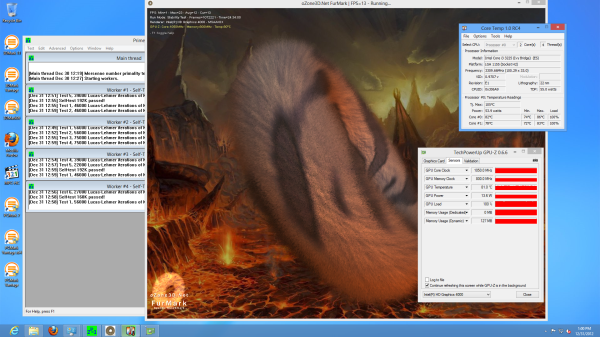
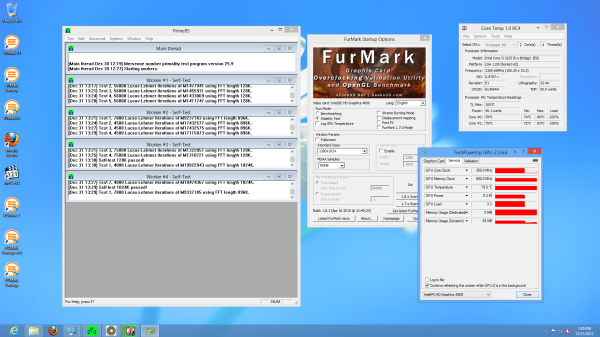
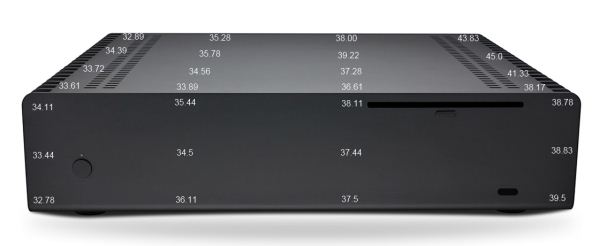
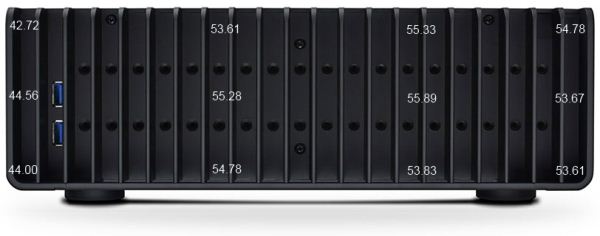
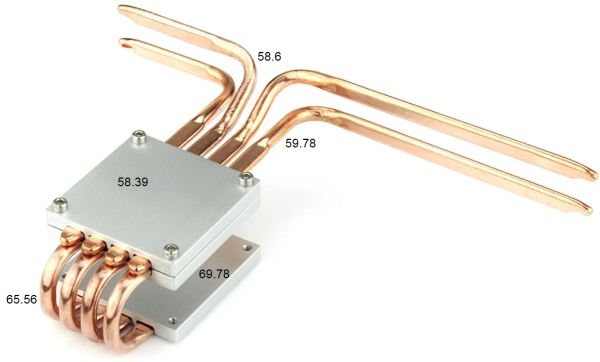








138 Comments
View All Comments
HighTech4US - Sunday, January 20, 2013 - link
Agree, I see no other overall complete platform that would be better (or even equal) for a 4-OTA Tuner DVR with unlimited storage (only limited by disk size) with free EPG that Windows 7 Media Center provides.And by tricking out 7MC with MediaBrowser, MediaControl, SHARK007 Codecs I have a complete on demand system that can play any type of media.
I use MediaCenterMaster to get program meta information, backdrops and thumbnails for MediaBrowser.
I also use MakeMKV to rip my DVD's and VideoReDo TVSuite h.264 to edit recorded TV shows and convert them to H.264 MKV's.
Oh and 7MC can show your digital pictures as a slide show on your big screen with background music.
I also love the screen saver where it shows random pictures from your picture library then zooms to one (or more) from a folder. When I first got this enabled the wife spent 45 minutes just watching the screen saver.
powerarmour - Monday, January 21, 2013 - link
Agreed, WMC is only EPG based Tuner app that can correctly use Freeview HD DVB-T2 Tuners in the UK, there are no other usable HTPC alternatives.psuedonymous - Sunday, January 20, 2013 - link
Question: why was the obsolete 2-pass method used instead of the faster (and more common) CRF? Was the encoding benchmark intended as an artificial CPU-stressing benchmark rather than a 'real world' encoding benchmark?ganeshts - Sunday, January 20, 2013 - link
Hmm.. that is what Graysky's benchmark does, and it keeps the setting consistent across different systems when you want to see how much better or worse your system is, when compared to someone else's.FWIW, pass 1 stresses the memory subsystem, while pass 2 stresses the CPU.
ganeshts - Sunday, January 20, 2013 - link
Thanks for the info. I was looking at the FAQ hosted by TechARP here: http://www.techarp.com/showarticle.aspx?artno=442&... ;Also, look at Ian's test with various memory speeds here using the same processor (last section on this page):
http://www.anandtech.com/show/6372/memory-performa...
There is definitely an impact on pass 1 performance using different memory speeds and the impact is more than on pass 2.
Iketh - Sunday, January 20, 2013 - link
Why is Prime95 v25.9 used? That is grossly outdated. The latest official 27.7 is needed to tax Ivy Bridge with AVX instructions. All those temps and watts you got will increase significantly. Please revise your Prime95. An oversight like this is unacceptable.Not to mention the latest Intel compilers have been implementing AVX instructions for like 6+ months now even if the programmer didn't specifically write for it. AND Handbrake has been using AVX in about that same timeframe and is only increasing.....
ganeshts - Sunday, January 20, 2013 - link
I will definitely do some experiments with the new Prime95 and report back.ganeshts - Monday, January 21, 2013 - link
I repeated the CPU loading with the latest Prime95 (v27.7):http://i.imgur.com/lK0zqjR.png
The readings didn't go up significantly, but, yes, there is an increase. The power consumption at the wall increased from 58.25 to 62.56 W.
Thanks for bringing this to our attention, and we will make sure future reviews use the updated Prime95.
ganeshts - Monday, January 21, 2013 - link
Oh, but, with full GPU and CPU loading (using Furmark 1.10.3 - latest), the power at the wall is only 89.77 W (compared to 88.75 W earlier). The ~40 W / ~15W TDP distribution between the CPU and the GPU still remains the same.http://i.imgur.com/soCGAyk.jpg
I don't expect the steady state temperatures to be that different because the power increase at the wall is only 1 W.
ganeshts - Sunday, January 20, 2013 - link
Yes, the scaling algorithms affect the performance a lot.That is why I mentioned that we used the default settings: Bicubic with sharpness 75 for chroma (no anti-ringing filter), Lanczos 3-tap for image upscaling / Catmull-Rom for image downscaling (no anti-ringing filter or linear light scaling),
We will look at other scaling algorithms and their performance on the HD 4000 / GT 640 / AMD 7750 in the third part of the HTPC series.
Also, a note that if you are using HD 4000 (or any other Intel HD Graphics), I would strongly suggest looking at DXVA Scaling. Users might be surprised at the quality delivered without taxing the GPU too much.